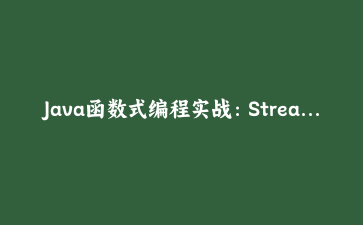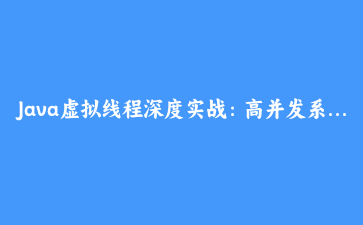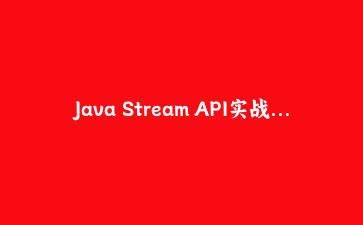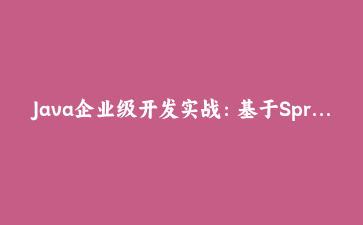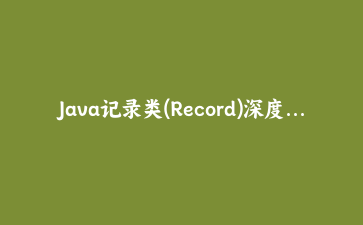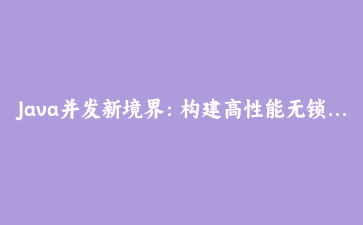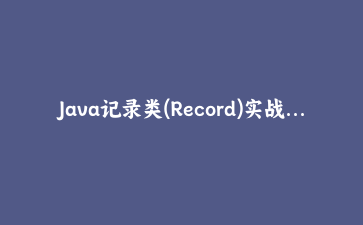一、函数式编程概述
Java 8引入了函数式编程范式,这是自Java 5以来最重要的语言特性更新。函数式编程的核心思想是将计算过程视为数学函数的求值,避免状态改变和可变数据,使代码更加简洁、可读和易于维护。
函数式编程的主要优势:
- 简洁性:减少样板代码,提高代码表达力
- 可读性:代码更接近问题描述而非实现细节
- 易于并行化:无状态操作天然适合并行处理
- 降低错误率:不可变数据和纯函数减少副作用
二、Lambda表达式详解
1. Lambda表达式语法
Lambda表达式是匿名函数的简洁表示方式,基本语法如下:
(parameters) -> expression
或
(parameters) -> { statements; }
2. Lambda表达式示例
// 传统匿名内部类
Runnable oldRunnable = new Runnable() {
@Override
public void run() {
System.out.println("Hello World");
}
};
// Lambda表达式
Runnable newRunnable = () -> System.out.println("Hello World");
// 带参数的Lambda
Comparator comparator = (s1, s2) -> s1.compareTo(s2);
// 多行语句的Lambda
Function doubleValue = x -> {
int result = x * 2;
return result;
};
3. 变量捕获
Lambda表达式可以捕获外部变量,但要求这些变量必须是final或等效final的:
int multiplier = 3;
Function multiplierFunction = x -> x * multiplier;
// multiplier必须是final或等效final(即初始化后不再修改)
三、函数式接口
1. 什么是函数式接口
函数式接口是只包含一个抽象方法的接口,可以使用@FunctionalInterface注解标注:
@FunctionalInterface
public interface Calculator {
int calculate(int x, int y);
// 默认方法不影响函数式接口的定义
default void printResult(int result) {
System.out.println("结果: " + result);
}
}
2. Java内置函数式接口
Java 8在java.util.function包中提供了大量常用函数式接口:
| 接口 | 描述 | 方法签名 |
|---|---|---|
| Function<T,R> | 接受一个参数,返回一个结果 | R apply(T t) |
| Predicate<T> | 接受一个参数,返回boolean值 | boolean test(T t) |
| Consumer<T> | 接受一个参数,无返回值 | void accept(T t) |
| Supplier<T> | 无参数,返回一个结果 | T get() |
| BiFunction<T,U,R> | 接受两个参数,返回一个结果 | R apply(T t, U u) |
3. 自定义函数式接口示例
@FunctionalInterface
interface TernaryOperator {
T apply(T a, T b, T c);
}
public class FunctionalInterfaceExample {
public static void main(String[] args) {
// 使用自定义函数式接口
TernaryOperator sumThenMultiply = (a, b, c) -> (a + b) * c;
int result = sumThenMultiply.apply(2, 3, 4); // (2+3)*4 = 20
System.out.println("结果: " + result);
}
}
四、方法引用与构造器引用
1. 方法引用类型
方法引用是Lambda表达式的简写形式,有四种类型:
// 1. 静态方法引用
Function parser = Integer::parseInt;
// 2. 实例方法引用(特定对象)
String prefix = "Hello";
Predicate startsWith = prefix::startsWith;
// 3. 实例方法引用(任意对象)
Function upperCase = String::toUpperCase;
// 4. 构造器引用
Supplier<List> listSupplier = ArrayList::new;
2. 方法引用实战示例
public class MethodReferenceExample {
public static void main(String[] args) {
List names = Arrays.asList("Alice", "Bob", "Charlie", "David");
// Lambda表达式
names.forEach(name -> System.out.println(name));
// 方法引用
names.forEach(System.out::println);
// 排序示例
names.sort((s1, s2) -> s1.compareTo(s2));
names.sort(String::compareTo);
// 映射示例
List lengths = names.stream()
.map(name -> name.length())
.collect(Collectors.toList());
List lengths2 = names.stream()
.map(String::length)
.collect(Collectors.toList());
}
}
五、Stream API深度解析
1. Stream操作分类
Stream操作分为中间操作和终端操作:
- 中间操作:返回Stream,可以链式调用(filter, map, sorted等)
- 终端操作:返回具体结果或产生副作用(collect, forEach, reduce等)
2. 创建Stream的多种方式
// 1. 从集合创建
List list = Arrays.asList("a", "b", "c");
Stream stream = list.stream();
// 2. 从数组创建
String[] array = {"a", "b", "c"};
Stream stream = Arrays.stream(array);
// 3. 使用Stream.of
Stream stream = Stream.of("a", "b", "c");
// 4. 使用Stream.generate(无限流)
Stream stream = Stream.generate(() -> "element");
// 5. 使用Stream.iterate(无限流)
Stream stream = Stream.iterate(0, n -> n + 2);
// 6. 从文件创建
try (Stream lines = Files.lines(Paths.get("file.txt"))) {
// 处理行数据
}
3. 常用Stream操作示例
public class StreamOperations {
public static void main(String[] args) {
List products = Arrays.asList(
new Product("Laptop", 1200, "Electronics"),
new Product("Phone", 800, "Electronics"),
new Product("Desk", 500, "Furniture"),
new Product("Chair", 150, "Furniture"),
new Product("Book", 20, "Education")
);
// 过滤和映射
List expensiveProductNames = products.stream()
.filter(p -> p.getPrice() > 300)
.map(Product::getName)
.collect(Collectors.toList());
// 排序
List sortedByPrice = products.stream()
.sorted(Comparator.comparing(Product::getPrice))
.collect(Collectors.toList());
// 分组
Map<String, List> productsByCategory = products.stream()
.collect(Collectors.groupingBy(Product::getCategory));
// 统计
DoubleSummaryStatistics stats = products.stream()
.mapToDouble(Product::getPrice)
.summaryStatistics();
System.out.println("平均价格: " + stats.getAverage());
System.out.println("最高价格: " + stats.getMax());
System.out.println("最低价格: " + stats.getMin());
}
}
class Product {
private String name;
private double price;
private String category;
// 构造方法、getter和setter省略
}
六、并行流与性能优化
1. 并行流使用
通过parallel()方法或将stream()替换为parallelStream()来创建并行流:
List numbers = Arrays.asList(1, 2, 3, 4, 5, 6, 7, 8, 9, 10);
// 顺序流
int sequentialSum = numbers.stream()
.reduce(0, (a, b) -> a + b);
// 并行流
int parallelSum = numbers.parallelStream()
.reduce(0, (a, b) -> a + b);
// 或者使用parallel()转换
int parallelSum2 = numbers.stream()
.parallel()
.reduce(0, (a, b) -> a + b);
2. 并行流注意事项
- 确保操作是无状态的,避免竞态条件
- 避免在并行流中使用有副作用的操作
- 对于小数据集,并行流可能比顺序流更慢
- 确保分解和合并操作的成本低于并行带来的收益
3. 自定义并行流示例
public class ParallelStreamExample {
public static void main(String[] args) {
long startTime, endTime;
List numbers = IntStream.rangeClosed(1, 1000000)
.boxed()
.collect(Collectors.toList());
// 顺序处理
startTime = System.currentTimeMillis();
long sequentialCount = numbers.stream()
.filter(n -> isPrime(n))
.count();
endTime = System.currentTimeMillis();
System.out.println("顺序流耗时: " + (endTime - startTime) + "ms");
// 并行处理
startTime = System.currentTimeMillis();
long parallelCount = numbers.parallelStream()
.filter(n -> isPrime(n))
.count();
endTime = System.currentTimeMillis();
System.out.println("并行流耗时: " + (endTime - startTime) + "ms");
}
private static boolean isPrime(int number) {
if (number <= 1) return false;
for (int i = 2; i <= Math.sqrt(number); i++) {
if (number % i == 0) return false;
}
return true;
}
}
七、实战案例:数据处理管道
1. 复杂数据处理示例
public class DataProcessingPipeline {
public static void main(String[] args) {
List employees = Arrays.asList(
new Employee("Alice", "HR", 30, 50000),
new Employee("Bob", "IT", 35, 75000),
new Employee("Charlie", "IT", 28, 60000),
new Employee("David", "Finance", 42, 80000),
new Employee("Eve", "HR", 29, 55000),
new Employee("Frank", "Finance", 38, 90000)
);
// 构建数据处理管道
Map avgSalaryByDept = employees.stream()
.filter(e -> e.getAge() > 30) // 过滤年龄大于30的员工
.collect(Collectors.groupingBy(
Employee::getDepartment, // 按部门分组
Collectors.averagingDouble(Employee::getSalary) // 计算平均薪资
));
// 找出薪资最高的部门
Optional<Map.Entry> highestAvgDept = avgSalaryByDept.entrySet().stream()
.max(Map.Entry.comparingByValue());
highestAvgDept.ifPresent(entry ->
System.out.println("平均薪资最高的部门: " + entry.getKey() +
", 平均薪资: " + entry.getValue()));
// 复杂统计:各部门薪资统计
Map statsByDept = employees.stream()
.collect(Collectors.groupingBy(
Employee::getDepartment,
Collectors.summarizingDouble(Employee::getSalary)
));
statsByDept.forEach((dept, stats) -> {
System.out.println(dept + "部门 - " +
"人数: " + stats.getCount() +
", 平均薪资: " + stats.getAverage() +
", 最高薪资: " + stats.getMax() +
", 最低薪资: " + stats.getMin());
});
}
}
class Employee {
private String name;
private String department;
private int age;
private double salary;
// 构造方法、getter和setter省略
}
2. 自定义收集器示例
public class CustomCollectorExample {
public static void main(String[] args) {
List numbers = Arrays.asList(1, 2, 3, 4, 5, 6, 7, 8, 9, 10);
// 自定义收集器:计算数字的平方和
Collector sumOfSquaresCollector = Collector.of(
() -> new int[1], // 供应器
(acc, num) -> acc[0] += num * num, // 累加器
(acc1, acc2) -> {
acc1[0] += acc2[0];
return acc1;
}, // 组合器(用于并行流)
acc -> acc[0] // 完成器
);
int sumOfSquares = numbers.stream()
.collect(sumOfSquaresCollector);
System.out.println("平方和: " + sumOfSquares);
}
}
八、最佳实践与常见陷阱
1. 函数式编程最佳实践
- 优先使用方法引用代替简单的Lambda表达式
- 保持Lambda表达式简短,复杂逻辑提取为方法
- 避免在Lambda中修改外部状态
- 合理使用并行流,注意线程安全问题
- 使用Optional避免NullPointerException
2. 常见陷阱与解决方案
// 陷阱1:在Lambda中修改外部变量
List numbers = Arrays.asList(1, 2, 3);
int[] sum = {0};
numbers.forEach(n -> sum[0] += n); // 使用数组绕过final限制(不推荐)
// 解决方案:使用reduce操作
int properSum = numbers.stream().reduce(0, Integer::sum);
// 陷阱2:异常处理
List filePaths = Arrays.asList("file1.txt", "file2.txt");
filePaths.stream()
.map(path -> {
try {
return Files.readAllLines(Paths.get(path));
} catch (IOException e) {
throw new RuntimeException(e);
}
})
.collect(Collectors.toList());
// 解决方案:提取方法或使用工具类
filePaths.stream()
.map(FileUtils::readLinesSafe)
.collect(Collectors.toList());
class FileUtils {
public static List readLinesSafe(String path) {
try {
return Files.readAllLines(Paths.get(path));
} catch (IOException e) {
return Collections.emptyList();
}
}
}
九、总结
Java函数式编程通过Lambda表达式和Stream API极大地提升了语言的表现力和数据处理能力。本文详细介绍了函数式编程的核心概念、语法特性以及实际应用场景,帮助开发者编写更简洁、可读和高效的代码。
在实际开发中,应根据具体场景选择合适的编程范式。函数式编程特别适合数据处理、转换和管道操作,而面向对象编程更适合建模复杂领域和状态管理。合理结合两种范式可以发挥Java语言的最大优势。
随着Java版本的迭代,函数式编程特性还在不断丰富和完善。掌握这些特性不仅能够提高代码质量,还能为应对未来的编程范式变化做好准备。


